Current Assessment and Future Outlook for Water Resources Considering Climate Change and a Population Burst: A Case Study of Ciliwung River, Jakarta City, Indonesia
Abstract
:1. Introduction and Research Background
2. Study Area
3. Methods
3.1. Basic Information Regarding the Model and Data Requirements
3.2. Hydrologic Modeling
3.3. Stream Water Quality Modeling
- BODinit = BOD concentration at the beginning of the reach (mg/L)
- BODfinal = BOD concentration at the end of the reach (mg/L)
- t = water temperature (in °C)
- H = water depth (m)
- L = reach length (m)
- U = water velocity in the reach
- vs = settling velocity (m/s)
- kr, kd and ka = total removal, decomposition and aeration rate constants (L/time)
- kd20 = decomposition rate at the reference temperature (20 °C)
- Ofinal = oxygen concentration at the end of the reach (mg/L)
- Oinitial = oxygen concentration at the beginning of the reach (mg/L)
3.4. Model Setup
4. Results and Discussion
4.1. Model Performance Evaluation
4.2. Future Simulation and Scenario Analyses
5. Conclusions
Supplementary Materials
Supplementary File 1Acknowledgments
Author Contributions
Conflicts of Interest
References
- United Nations Environment Programme (UNEP). The UN-Water Status Report on the Application of Integrated Approaches to Water Resources Management. Available online: http://www.unwater.org/publications/un-water-status-report-application-integrated-approaches-water-resources-management-rio20/ (accessed on 12 August 2012).
- Bos, R.; Alves, D.; Latorre, C.; Macleod, N.; Payen, G.; Roaf, V.; Rouse, M. Manual on the Human Right to Safe Drinking Water and Sanitation for Practitioners; IWA Publications: London, UK, 2016; p. 120. [Google Scholar]
- Asefa, T.; Clayton, J.; Adams, A.; Anderson, D. Performance evaluation of a water resources system under varying climatic conditions: Reliability, resilience, vulnerability and beyond. J. Hydrol. 2014, 508, 53–65. [Google Scholar] [CrossRef]
- Goharian, E.; Burian, S.; Bardsley, T.; Strong, C. Incorporating Potential Severity into Vulnerability Assessment of Water Supply Systems under Climate Change Conditions. J. Water Resour. Plan. Manag. 2015. [Google Scholar] [CrossRef]
- Zimmerman, J.B.; Mihelcic, J.R.; Smith, J. Global stressors on water quality and quantity. Environ. Sci. Technol. 2008, 42, 4247–4254. [Google Scholar] [CrossRef] [PubMed]
- Malsy, M.; Flörke, M.; Borchardt, D. What drives the water quality changes in the Selenga Basin: Climate change or socio-economic development? Reg. Environ. Chang. 2016, 1–13. [Google Scholar] [CrossRef]
- United Nations World Water Assessment Programme (WWAP). The United Nations World Water Development Report 2015: Water for a Sustainable World; UNESCO: Paris, France, 2015. [Google Scholar]
- Goharian, E.; Burian, S.J.; Lillywhite, J.; Hile, R. Vulnerability assessment to support integrated water resources management of metropolitan water supply systems. J. Water Resour. Plan. Manag. 2017, 143, 3. [Google Scholar] [CrossRef]
- Karamouz, M.; Goharian, E.; Nazif, S. Reliability Assessment of the Water Supply Systems under Uncertain Future Extreme Climate Conditions. Earth Interact. 2013, 17, 1–27. [Google Scholar] [CrossRef]
- Hughes, D.A.; Kapangaziwiri, E.; Mallroy, S.J.L.; Wagener, T.; Smithers, J. Incorporating Uncertainty in Water Resource Simulation and Assessment Tools in South Africa; WRC Report No. 1838/1/11; Water Research Commission: Pretoria, South Africa, 2011. [Google Scholar]
- Pappenberger, F.; Beven, K.J. Ignorance is bliss: Or seven reasons not to use uncertainty analysis. Water Resour. Res. 2006, 42, W05302. [Google Scholar] [CrossRef]
- Beven, K.J.; Alcock, R.E. Modelling everything everywhere: A new approach to decision-making for water management under uncertainty. Freshw. Biol. 2012, 57, 124–132. [Google Scholar] [CrossRef]
- Jin, H.; Zhu, Q.; Zhao, X.; Zhang, Y. Simulation and prediction of climate variability and assessment of the response of water resources in a typical watershed in China. Water 2016, 8, 490. [Google Scholar] [CrossRef]
- McIntyre, N.R.; Wheater, H.S. A tool for risk-based management of surface water quality. Environ. Model. Softw. 2004, 19, 1131–1140. [Google Scholar] [CrossRef]
- Kumar, P.; Kumar, A.; Singh, C.K.; Saraswat, C.; Avtar, R.; Ramanathan, A.L.; Herath, S. Hydrogeochemical Evolution and Appraisal of Groundwater Quality in Panna District, Central India. Expo. Health 2016, 8, 19–30. [Google Scholar] [CrossRef]
- Deksissa, T.; Meirlaen, J.; Ashton, P.J.; Vanrolleghem, P.A. Simplifying dynamic river water quality modelling: A case study of inorganic dynamics in the Crocodile River, South Africa. Water Air Soil Pollut. 2004, 155, 303–320. [Google Scholar] [CrossRef]
- Cox, B.A. A review of currently available in-stream water-quality models and their applicability for simulating dissolved oxygen in lowland rivers. Sci. Total Environ. 2003, 314–316, 335–377. [Google Scholar] [CrossRef]
- Radwan, M.; Willems, P.; El-Sadek, A.; Berlamont, J. Modelling of dissolved oxygen and biochemical oxygen demand in river water using a detailed and a simplified model. Int. J. River Basin Manag. 2003, 1, 97–103. [Google Scholar] [CrossRef]
- Sieber, J.; Purkey, D. Water Evaluation and Planning System. User Guide for WEAP21; Stockholm Environment Institute, U.S. Center: Somerville, MA, USA, 2011; Available online: http://www.weap21.org/ (accessed on 1 April 2014).
- Ingol-Blanco, E.; McKinney, D. Development of a Hydrological Model for the Rio Conchos Basin. J. Hydrol. Eng. 2013, 18, 340–351. [Google Scholar] [CrossRef]
- Slaughter, A.R.; Mantel, S.K.; Hughes, D.A. Investigating possible climate change and development effects on water quality within an arid catchment in South Africa: A comparison of two models. In Proceedings of the 7th International Congress on Environmental Modelling and Software, San Diego, CA, USA, 15–19 June 2014; Ames, D.P., Quinn, N.W.T., Rizzoli, A.E., Eds.; ISBN 978-88-9035-744-2. [Google Scholar]
- Assaf, H.; Saadeh, M. Assessing water quality management options in the Upper Litani Basin, Lebanon, using an integrated GIS-based decision support system. Environ. Model. Softw. 2008, 23, 1327–1337. [Google Scholar] [CrossRef]
- Cook, C.; Bakker, K. Water security: Debating an emerging paradigm. Glob. Environ. Chang. 2012, 22, 94–102. [Google Scholar] [CrossRef]
- Ravesteijn, W.; Kop, J. For Profit and Prosperity: The Contribution Made by Dutch Engineers to Public Works in Indonesia, 1800–2000; Koninklyk Instituut Voor Taal Land: Leiden, The Netherlands, 2008; p. 563. [Google Scholar]
- Amato, C.C.; McKinney, D.C.; Ingol-Blanco, E.; Teasley, R.L. WEAP Hydrology Model Applied: The Rio Conchos Basin, Center for Research in Water Resources; The University of Texas: Austin, TX, USA, 2006; Available online: https://repositories.lib.utexas.edu/handle/2152/7025 (accessed on 15 July 2014).
- Australian Aid. East Asia Pacific Region Urban Sanitation Review: Indonesia Country Study; World Bank Group: Washington, DC, USA, 2013; p. 68. [Google Scholar]
- Esteve, P.; Varela, C.O.; Blanco, I.G.; Downing, T.E. A hydro-economic model for the assessment of climate change impacts and adaptation in irrigated agriculture. Ecol. Econ. 2015, 120, 49–58. [Google Scholar] [CrossRef]
- Sunyer, M.A.; Hundecha, Y.; Lawrence, D.; Madsen, H.; Willems, P.; Martinkova, M.; Vormoor, K.; Bürger, G.; Hanel, M.; Kriauciuniene, J.; et al. Inter-comparison of statistical downscaling methods for projection of extreme precipitation in Europe. Hydrol. Earth Syst. Sci. 2015, 19, 1827–1847. [Google Scholar] [CrossRef]
- Christensen, J.H.; Boberg, F.; Christensen, O.B.; Lucas-Picher, P. On the need for bias correction of regional climate change projections of temperature and precipitation. Geophys. Res. Lett. 2008, 35, L20709. [Google Scholar] [CrossRef]
- Hansen, J.W.; Challinor, A.; Ines, A.; Wheeler, T.; Moron, V. Translating climate forecasts into agricultural terms: Advances and challenges. Clim. Res. 2006, 33, 27–41. [Google Scholar] [CrossRef]
- Mishra, B.K.; Herath, S. Assessment of Future Floods in the Bagmati River Basin of Nepal Using Bias-Corrected Daily GCM Precipitation Data. J. Hydrol. Eng. 2014. [Google Scholar] [CrossRef]
- Elshamy, M.E.; Seierstad, I.A.; Sorteberg, A. Impacts of climate change on Blue Nile flows using bias-corrected GCM scenarios. Hydrol. Earth Syst. Sci. 2009, 13, 551–565. [Google Scholar] [CrossRef]
- Intergovernmental Panel on Climate Change (IPCC). Climate Change 2014: Synthesis Report. In Contribution of Working Groups I; II and III to the Fifth Assessment Report of the Intergovernmental Panel on Climate Change; Core Writing Team, Pachauri, R.K., Meyer, L.A., Eds.; IPCC: Geneva, Switzerland, 2014; p. 151. [Google Scholar]
- Bowie, G.L.; Mills, W.B.; Porcella, D.B.; Campbell, C.L.; Pagenkopf, J.R.; Rupp, G.L.; Johnson, K.M.; Chan, P.W.H.; Gherini, S.A. Rates, Constants and Kinetics Formulations in Surface Water Quality Modeling, 2nd ed.; EPA 600/3-85/040; US EPA: Athens, GA, USA, 1985.
- World Health Organization. Global Water Supply and Sanitation Assessment 2000 Report; WHO and UN Children’s Fund: New York, NY, USA, 2000. [Google Scholar]
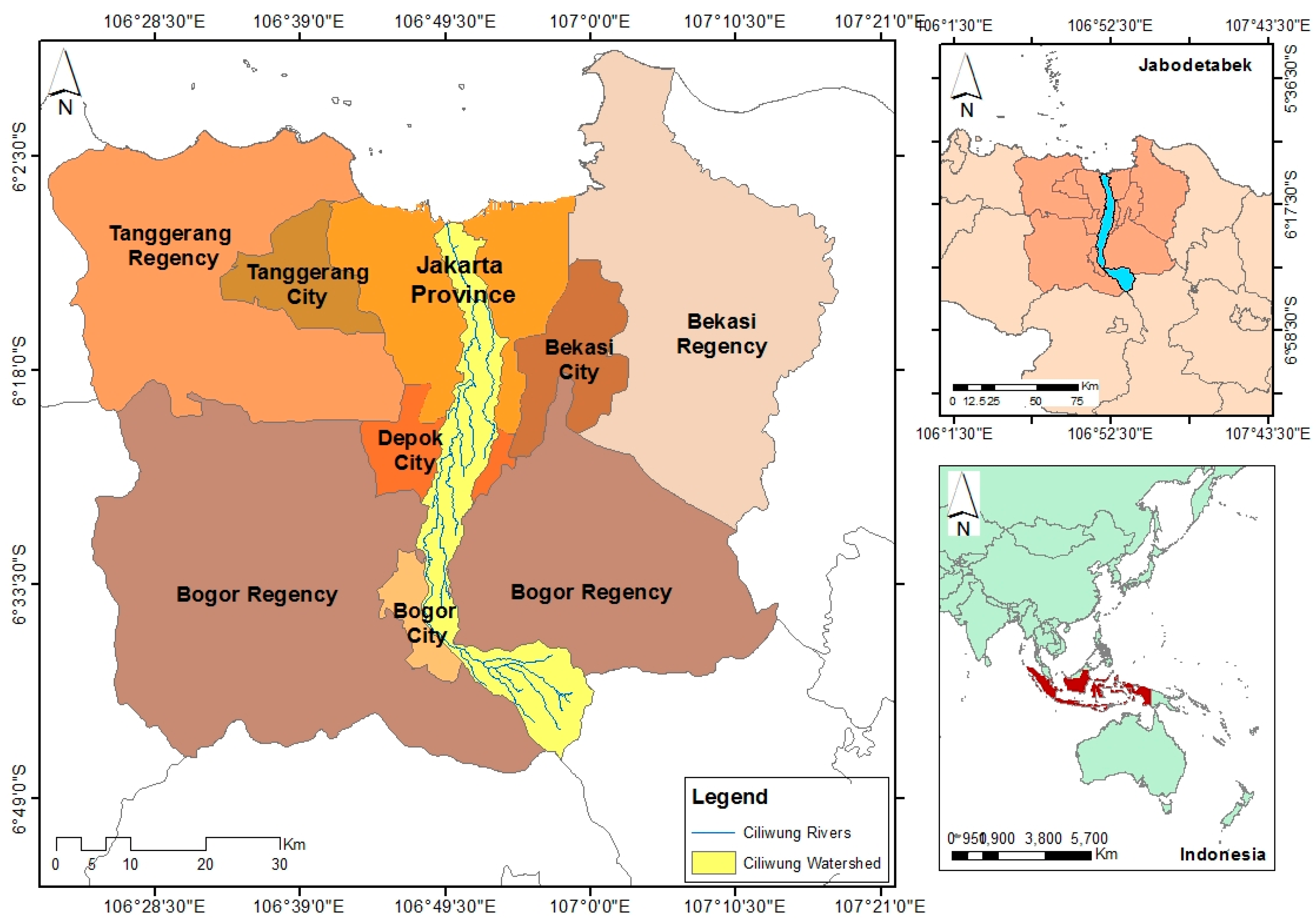

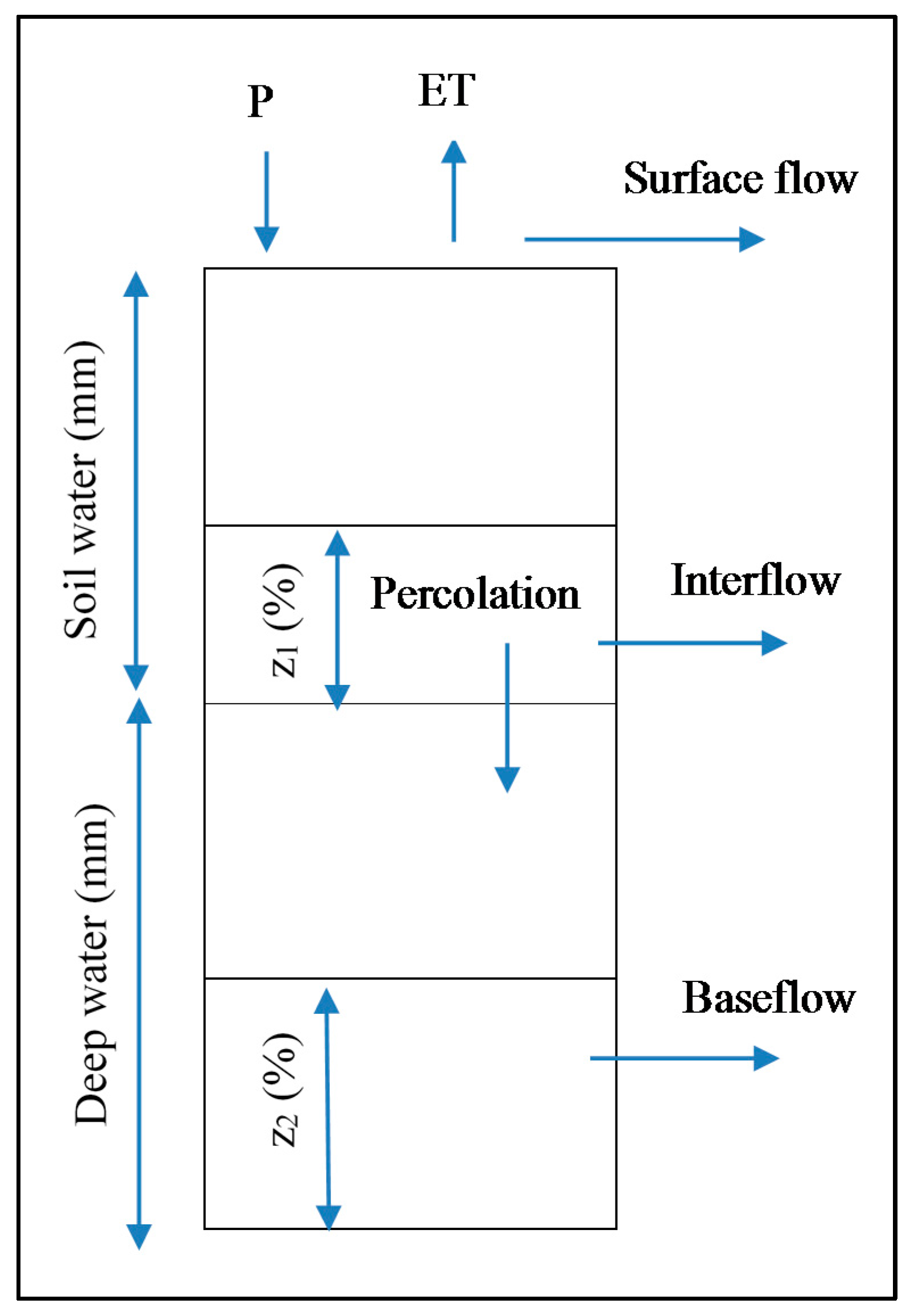

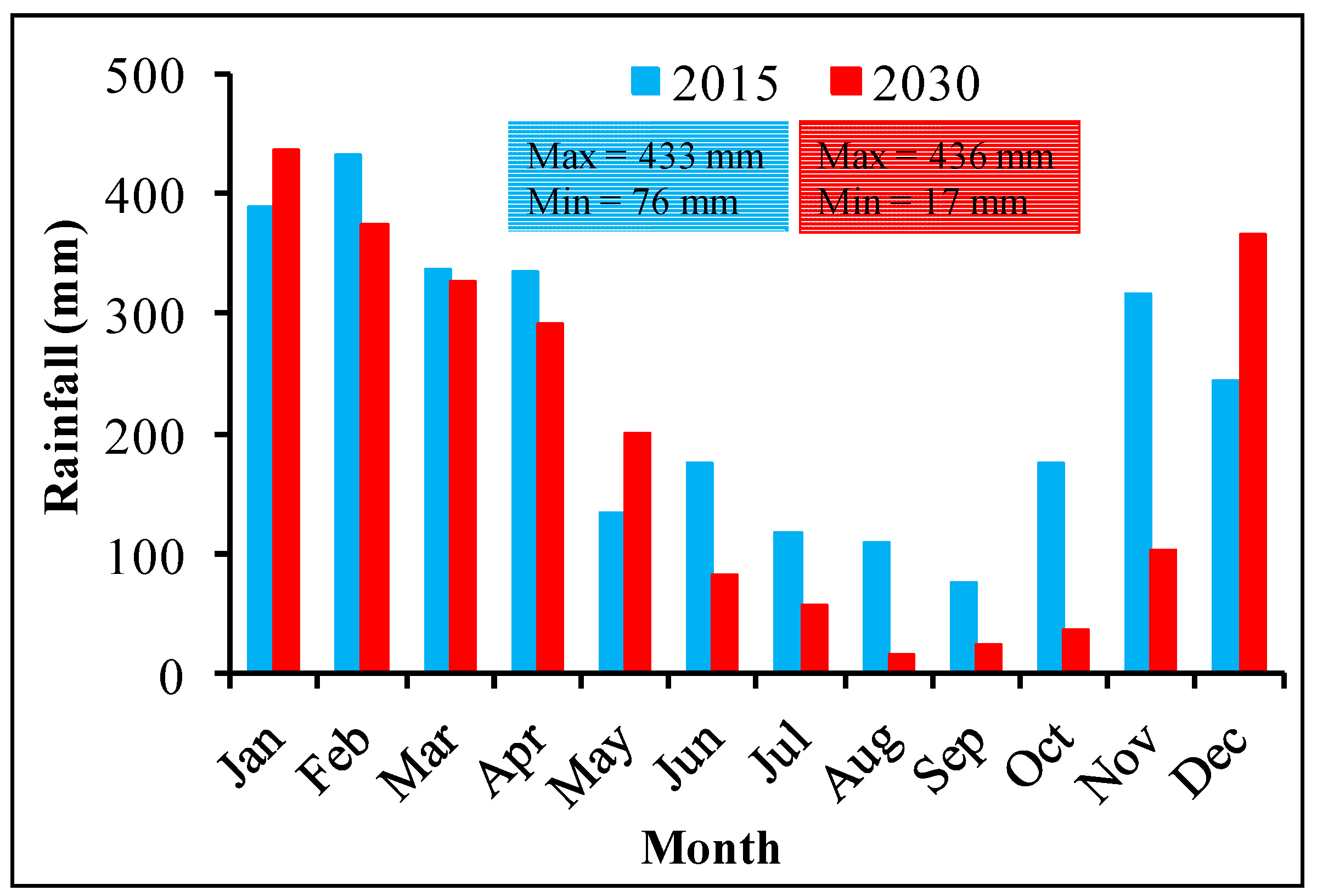
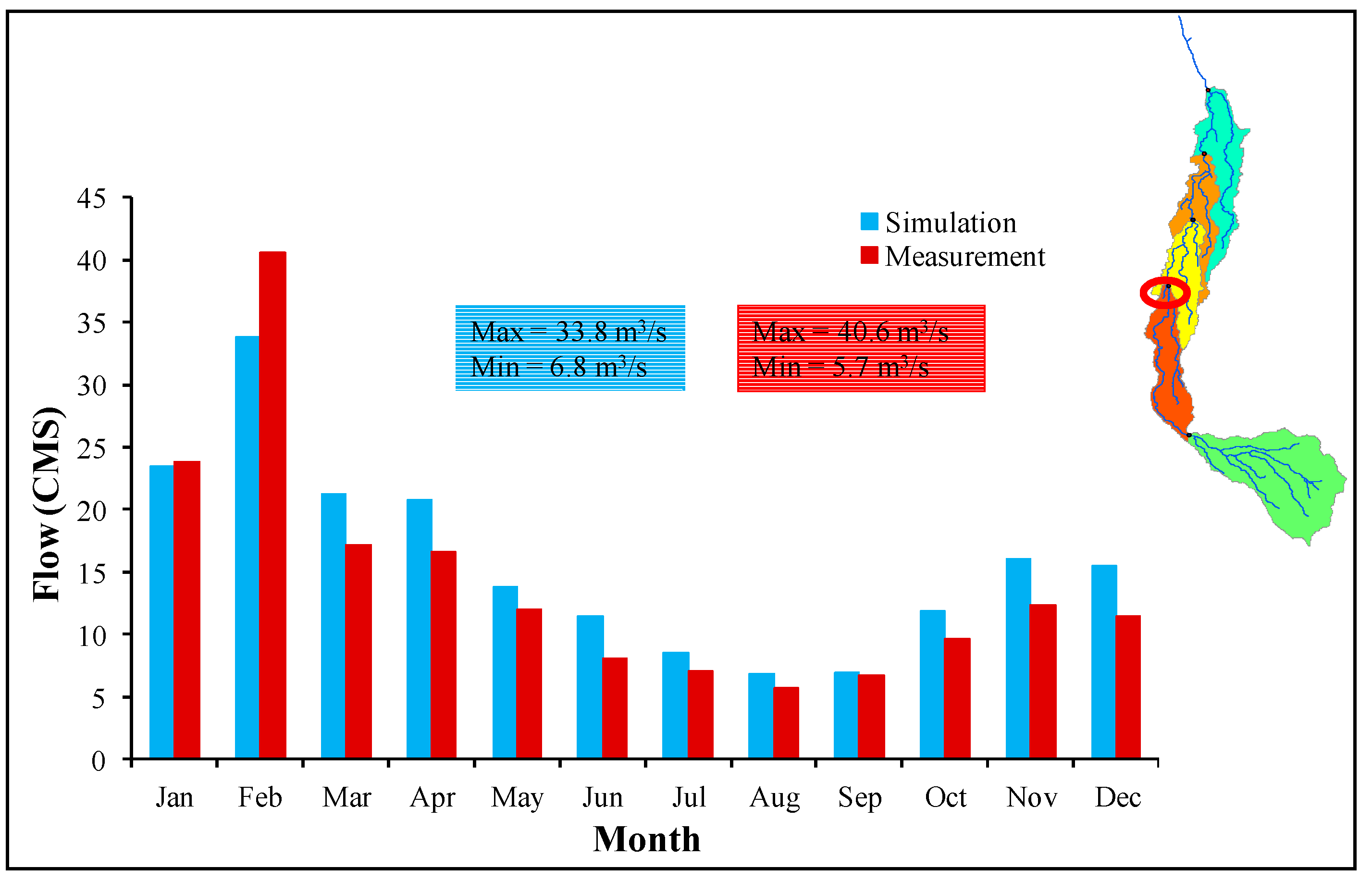


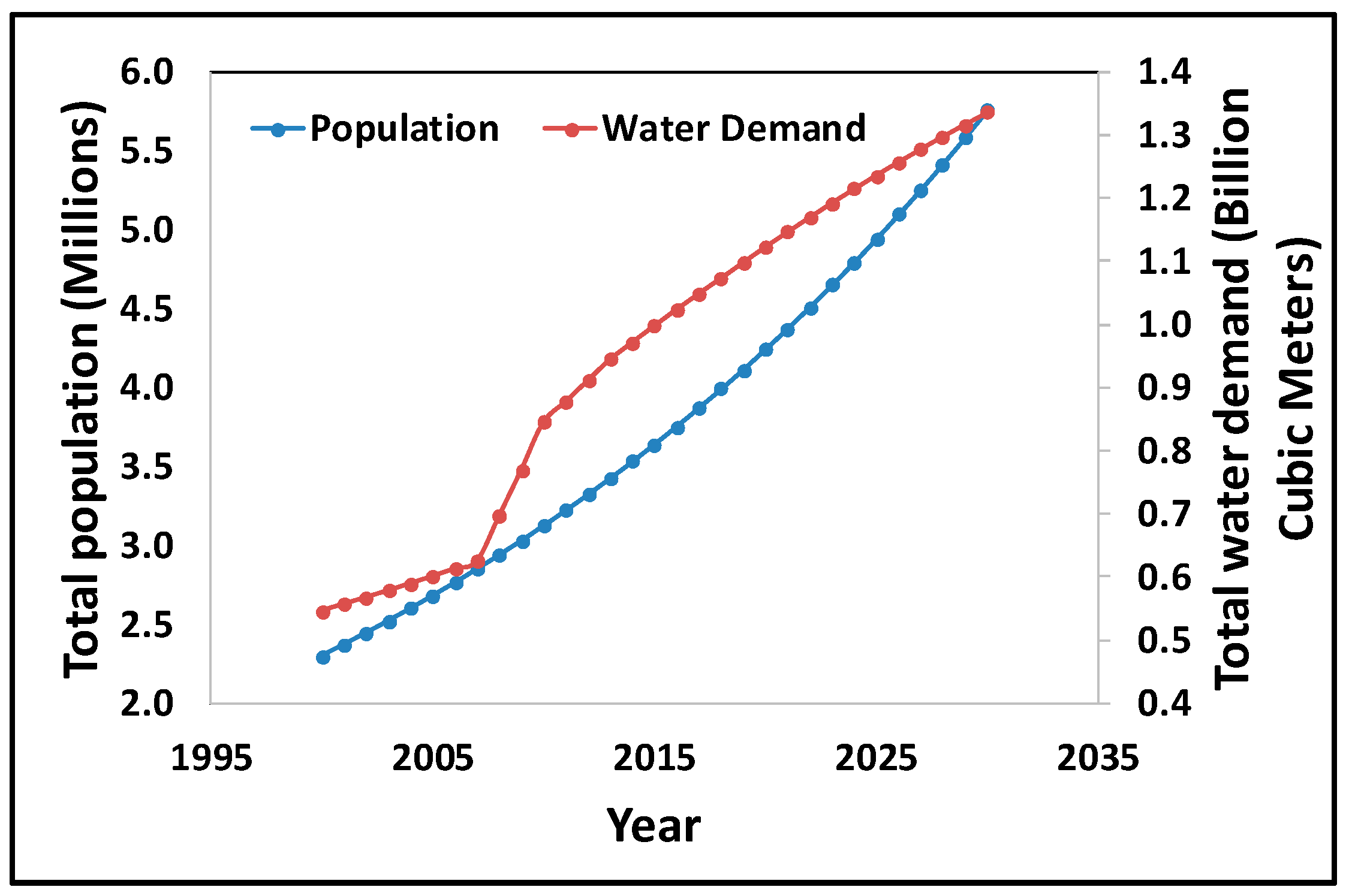
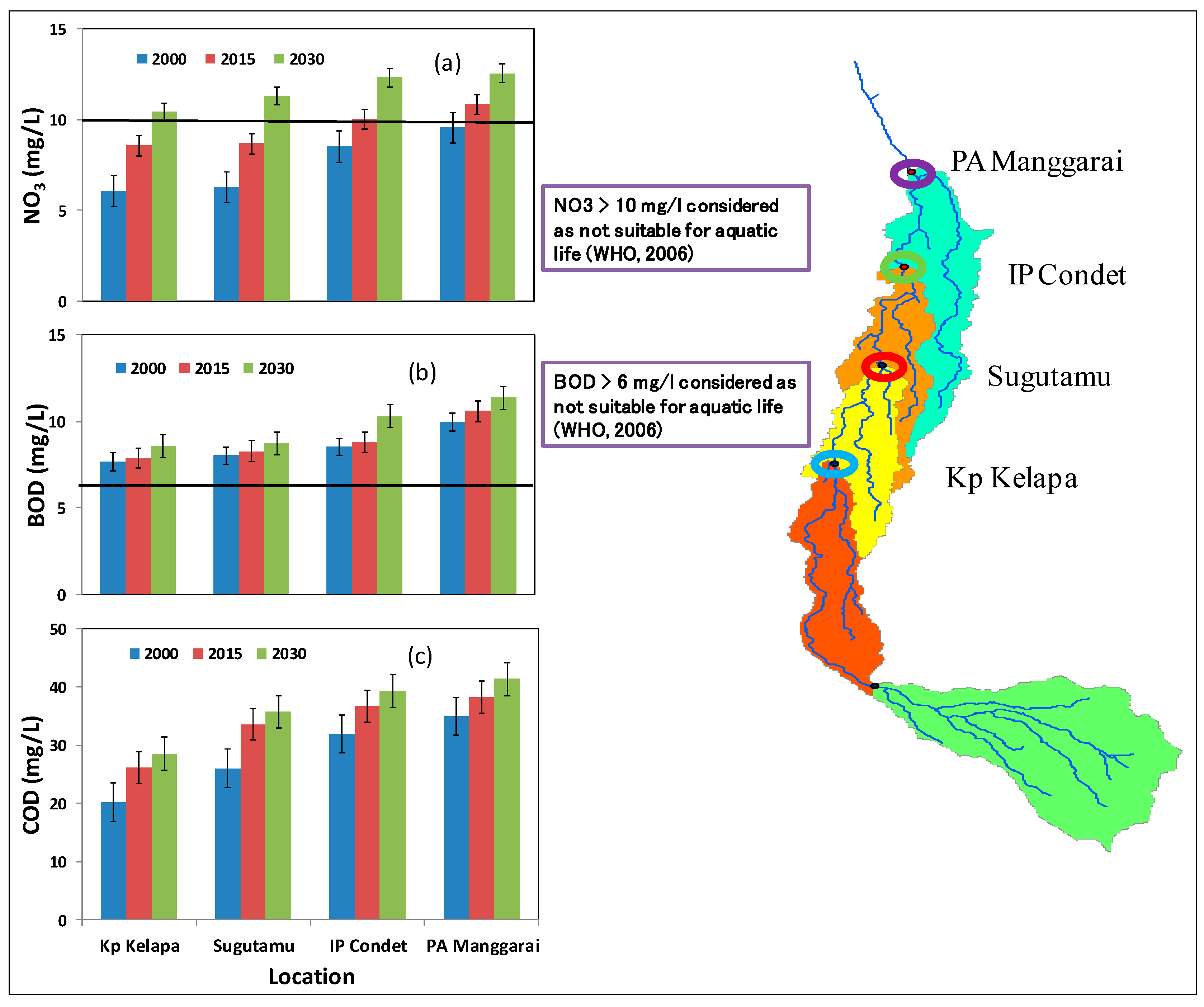
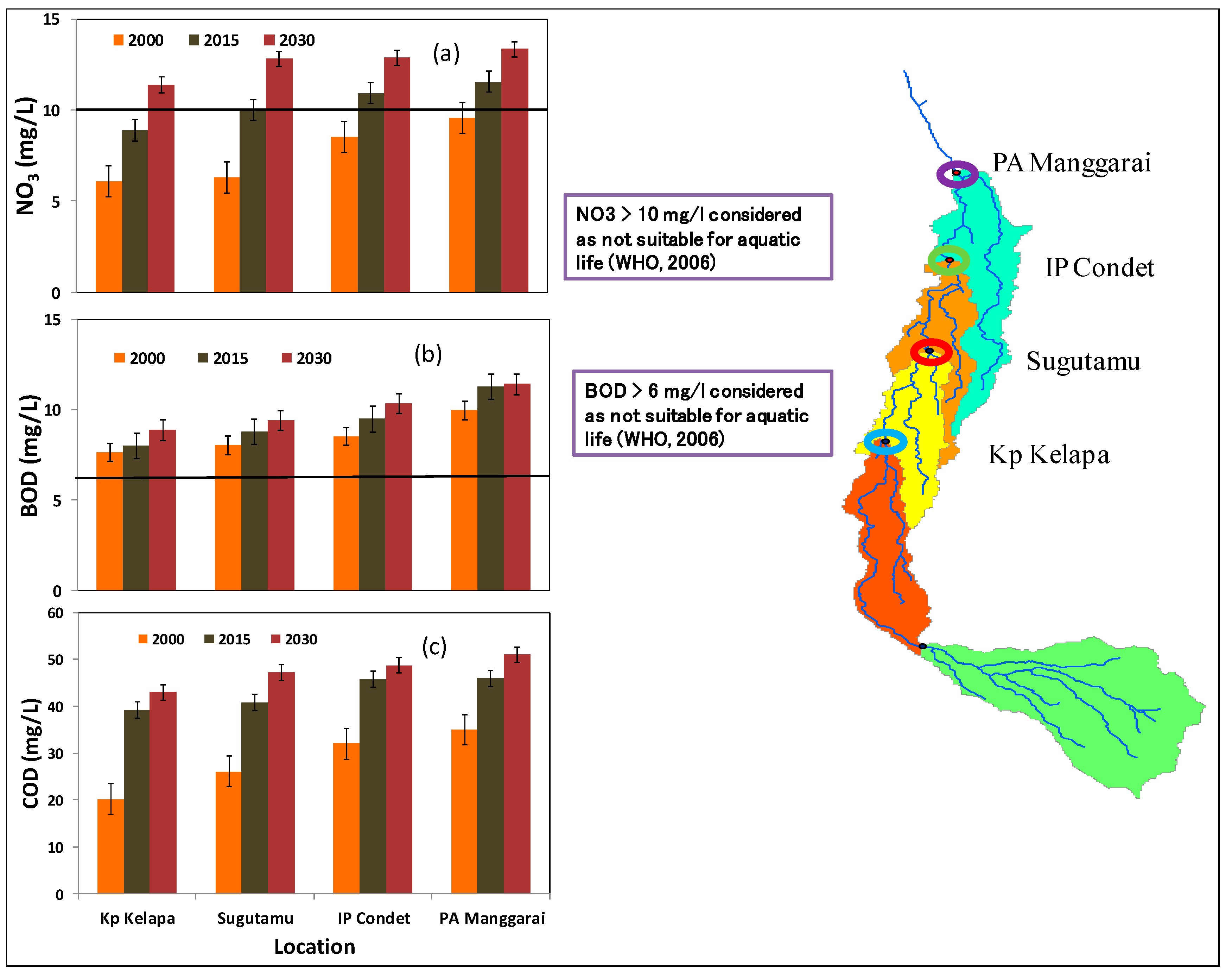
| Year | Katulampa | KP Kelapa | Sugutamu | IP Condet | PA Manggarai |
|---|---|---|---|---|---|
| 2000 | 167,081 | 341,593 | 424,851 | 431,276 | 937,694 |
| 2007 | 212,372 | 491,636 | 499,155 | 449,155 | 966,153 |
| 2010 | 301,390 | 719,690 | 683,279 | 584,649 | 1,244,221 |
| 2015 | 386,463 | 938,731 | 819,270 | 652,527 | 1,373,714 |
| 2020 | 487,259 | 1,100,199 | 928,130 | 721,519 | 1,487,356 |
| 2030 | 752,479 | 1,358,621 | 1,108,621 | 873,167 | 1,667,095 |
| Wastewater Treatment Plant | Design Capacity (in Million Litre per Day (MLD)) | Design Effluent Standard (BOD mg/L) | Coverage Area (% of Population Served) | ||||||
|---|---|---|---|---|---|---|---|---|---|
| 2000 (Baseline) | 2020 | 2030 | 2000 | 2020 | 2030 | 2000 | 2020 | 2030 | |
| Setiabudi | 22 | 37 | 54 | 60 | 33 | 24 | 2 | 5 | 5 |
| Wijaya Kususma and Duri Kosambi | - (Not working) | 264 | 313 | - | 24 | 20 | - | 35 | 55 |
| Sawah Besar | - (Not working) | - (Not working) | 337 | - | - | 20 | - | - | 85 |
| Parameter | Initial Value | Step |
|---|---|---|
| Effective precipitation | 100% | ±0.5% |
| Runoff/infiltration ratio | 50/50 | ±5/5 |
© 2017 by the authors. Licensee MDPI, Basel, Switzerland. This article is an open access article distributed under the terms and conditions of the Creative Commons Attribution (CC BY) license (http://creativecommons.org/licenses/by/4.0/).
Share and Cite
Kumar, P.; Masago, Y.; Mishra, B.K.; Jalilov, S.; Rafiei Emam, A.; Kefi, M.; Fukushi, K. Current Assessment and Future Outlook for Water Resources Considering Climate Change and a Population Burst: A Case Study of Ciliwung River, Jakarta City, Indonesia. Water 2017, 9, 410. https://doi.org/10.3390/w9060410
Kumar P, Masago Y, Mishra BK, Jalilov S, Rafiei Emam A, Kefi M, Fukushi K. Current Assessment and Future Outlook for Water Resources Considering Climate Change and a Population Burst: A Case Study of Ciliwung River, Jakarta City, Indonesia. Water. 2017; 9(6):410. https://doi.org/10.3390/w9060410
Chicago/Turabian StyleKumar, Pankaj, Yoshifumi Masago, Binaya Kumar Mishra, Shokhrukh Jalilov, Ammar Rafiei Emam, Mohamed Kefi, and Kensuke Fukushi. 2017. "Current Assessment and Future Outlook for Water Resources Considering Climate Change and a Population Burst: A Case Study of Ciliwung River, Jakarta City, Indonesia" Water 9, no. 6: 410. https://doi.org/10.3390/w9060410
APA StyleKumar, P., Masago, Y., Mishra, B. K., Jalilov, S., Rafiei Emam, A., Kefi, M., & Fukushi, K. (2017). Current Assessment and Future Outlook for Water Resources Considering Climate Change and a Population Burst: A Case Study of Ciliwung River, Jakarta City, Indonesia. Water, 9(6), 410. https://doi.org/10.3390/w9060410







